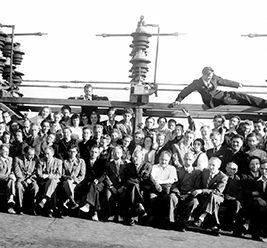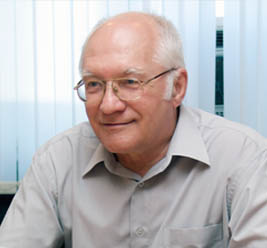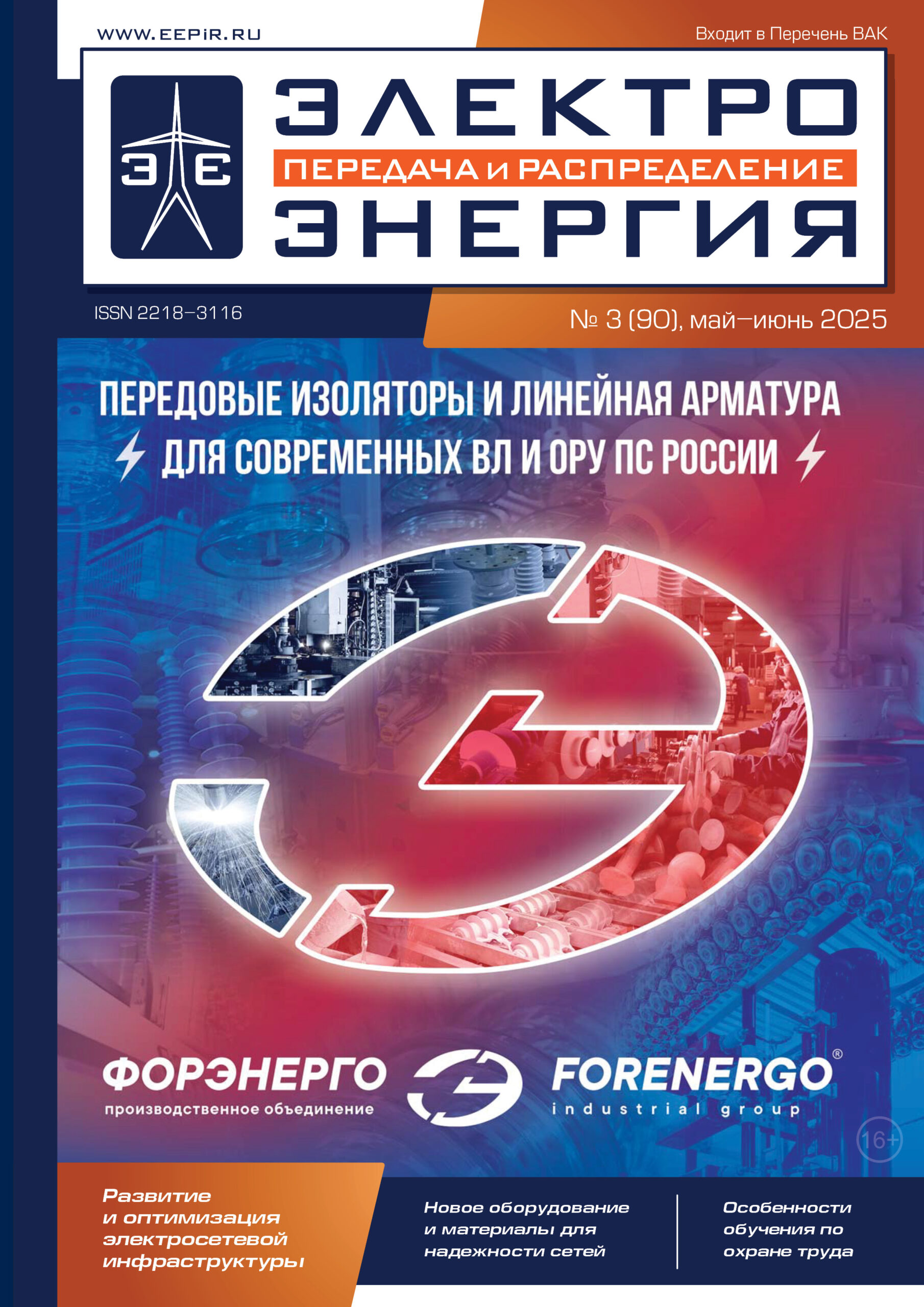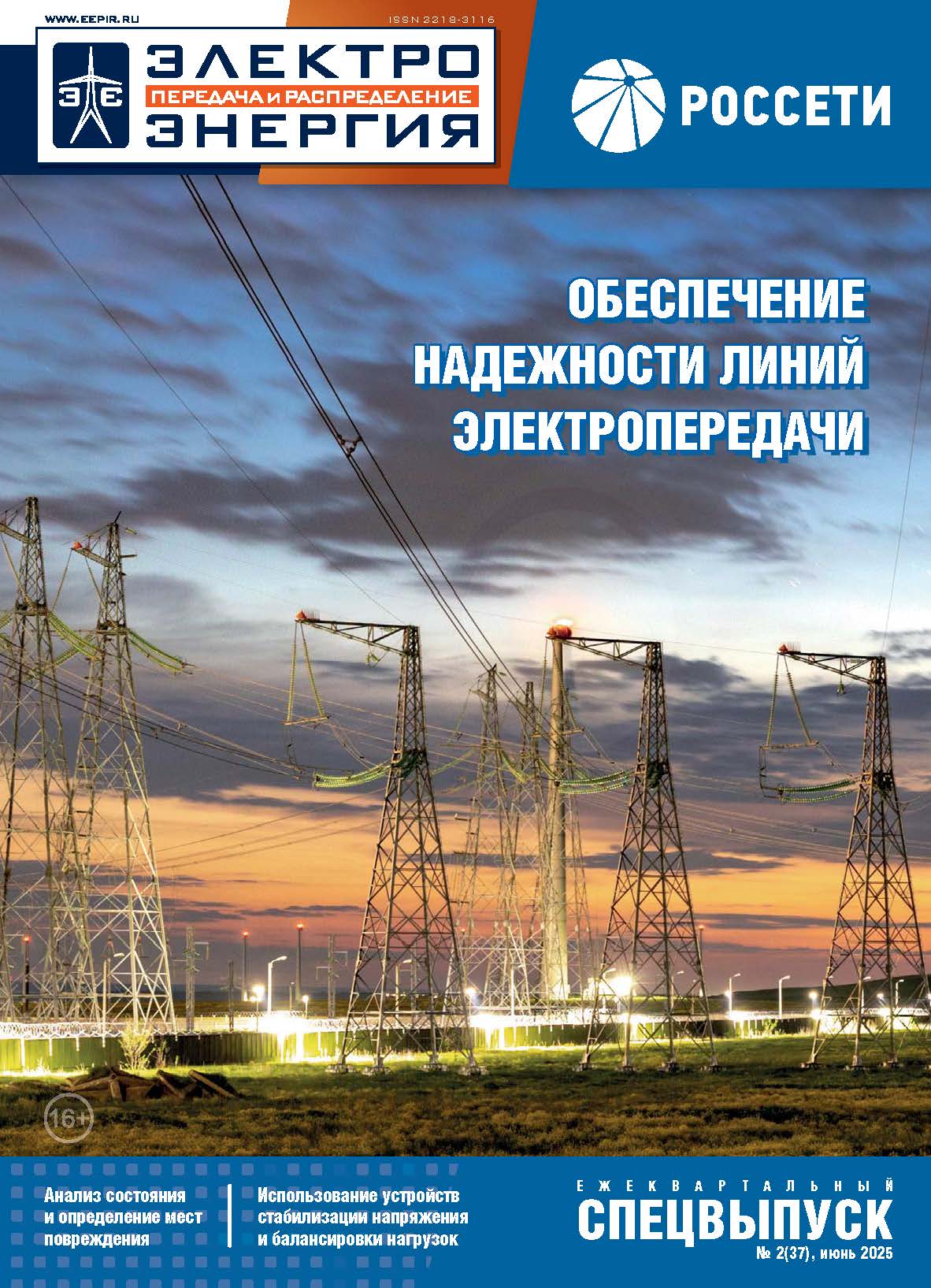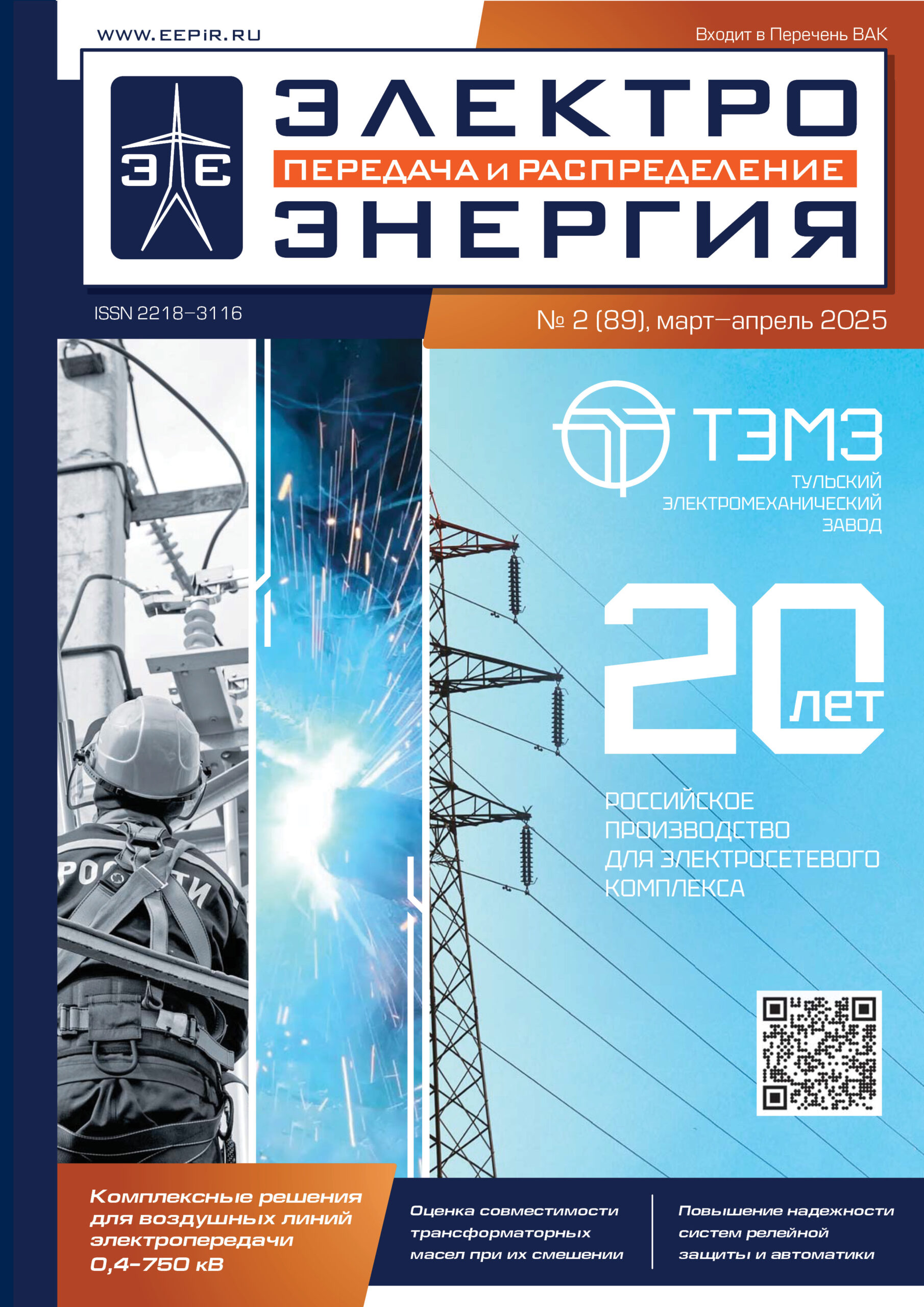
The MAIN JOURNAL for POWER GRID SPECIALISTS in RUSSIA
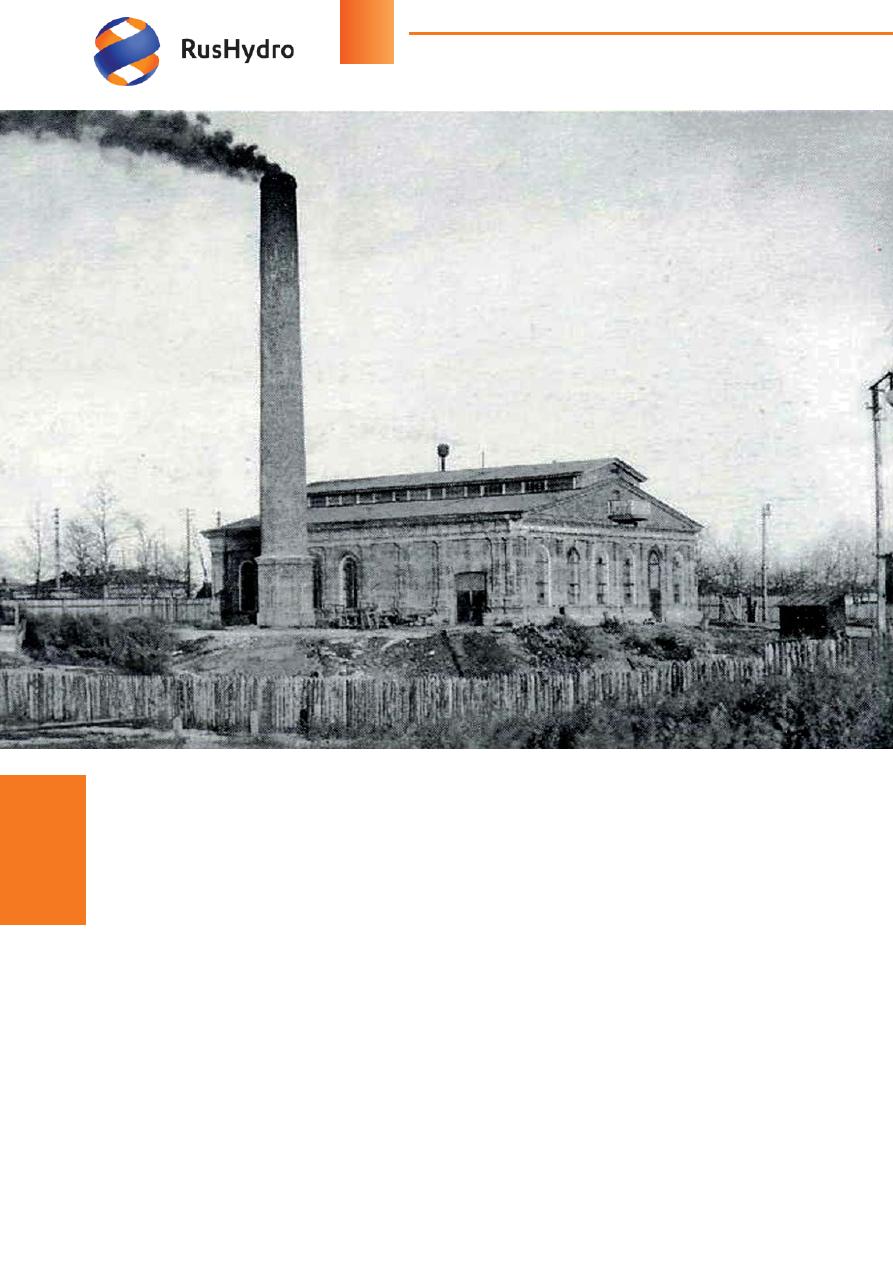
6
CENTURY OF THE FAR EAST
POWER ENGINEERING
elec trical equipment, electri
fi
cation
of city infrastructure units and the
industrial enterprises in the country
the new sector of economy –
power engineering industry
began to arise step by step.
The
fi
rst electrical power plants
began to appear in Moscow and
St. Petersburg in the 1880`s when
Museum
More than a century has passed since the time when on the Far East territory of
Russia the
fi
rst electrical power plants were put into operation: the cities have lit
up with the light of electrical street lamps and the
fi
rst trams have started to run
up and down the streets. For those years everything has happened in the power
engineering sphere: shock-work construction, valiant labor, wars, recession and
renewal… Today we remember how the history of power engineering from
the
fi
rst lokomobile to the modern HPP has been forming.
The origins of electrical
power engineering in Russia
are connected with the industrial
revolution ending in late 70`s –
early 80`s of the 19th century and
with the beginning of the national
economy modernization. As
a result of the discoveries in the
fi
eld of electricity, development of
Blagoveshchenskaya electrical power plant.
Beginning of the 20th century

7
the Kremlin in Moscow and the
Winter Palace in St. Petersburg
were illuminated.
Electricity of the
Tsarist-era
Approximately at the same
time the
fi
rst small power
plants began to appear also in
the Far East. The military and
industrialists were the
fi
rst who
decided to illuminate their units.
For that purpose they used
lokomobiles and elementary ge-
nera tors, but its capacities were
insuf
fi
cient for the whole city
supply with electrical power.
In October, 1906 start of the
1st city power plant in the Far
East, in Khabarovsk, took place.
Owner of the large industrial
enterprise “Arsenal” Simeon
Vankov became the initiator of its
construction. He developed the
project of power plant by himself
and ordered the equipment from
Germany. Electrical power plant
electric capacity was 120 kW,
and very soon the plant started
to illuminate apartments and
several streets in Khabarovsk.
In Vladivostok works on con-
struction of the electrical power
plant began only in the beginning
of 1911. Unlike the Khabarovsk
plant, electric capacity of the
fi
rst
serious unit of power generation in
Primorye was 1350 kW.
The contract on the power plant
construction was signed with the
Vladivostok of
fi
ce of the Russian
company “Universal electricity
company”. Within the project two
water pipe steam boilers by the
system “Babcock and Wilcox“
and two turbine-type alternatives
on three-phase current with the
electric capacity of 675 kW each
were installed at the station.
Suchansky Rudnik coal served as
fuel for the station.
All necessary tests of the
equipment of the power plant
and electrical networks of the city
had been completed by February,
1912. Already on February 18,
1912 the public Vladivostok city
electrical power plant for general
use was put into operation on
the permanent mode. By June,
1912 the station provided with
electrical power 980 customers of
Vladivostok.
The Era
of Convulsion
The 1st World War, the revo-
lution and the civil war resulted in
pre-existing electrical power plants
decline and it made the govern ment
to shelve its plans on new units’
construction. Thus the Vladivos-
tokskaya electrical power plant
number 1 had appeared to be in re-
ally horrible condition by the year of
1920. Despite the municipal admin-
istration had installed a twin-ended
boiler on the basis of “Gaine” sys-
tem the plant was not able to meet
the city electrical power needs. As
a result a great quantity of consum-
ers had to be switched to the pow-
er plant which supplied Far East-
ern state mechanical shipbuilding
factory (now Dalzavod).
Khabarovskaya
electrical power plant.
Beginning of the
20th century
Extension of Vladivostok
electrical power network.
1916
Vladivostokskaya
electrical power plant.
1920`s

8
Nevertheless, in 1924 the new
Soviet regime made a capital repair
of all boilers and steam-turbines
of the Vladivostokskaya electrical
power plant #1 and also increased
the plant capacity to 2775 kW.
Eventually by November 1924 the
power consumers quantity reached
the level of 4500 customers.
Stalin’s
Construction
Sites
In 1920 the GOELRO plan was
adopted in the country. It imposed
the construction of 30 huge power
plants with rated electric power of
8.8 billion kilowatt hours annually in
the period of 10-15 years. Despite
the fact that
fi
rstly the plan seemed
to be unachievable by the year
1935 the USSR got the second
place among the EU countries
in the sphere of electrical power
production.
The industrialization which
had started in Lenin’s epoch also
leaded to the large-scale ground-
breaking of the power facilities in
the Far East. As a result in 1930’s
several electrical power plants were
put into operation those like the
Khabarovsk public-service power
plant, Artemovskaya SDPP, the
Far East power plant of special
purpose, the Yakutskaya CHP
and the Amur shipbuilding factory
power plant #199 (now the
Komsomolskaya CHP).
In 1932 the reconstruction
works at the Vladivostokskaya
HPP #1 were completed. Three
“Babcock and Wilcox” boilers
and two “Bellis&Morcom” turbo-
alternators with the electric
capacity of 3000 kW each were
installed there. In 1935 turbo-
alternator with grounded collector
type with the electric capacity of
3000 kW was also installed and
then the plant electric capacity
became 11 000 kW.
One of the most famous among
the Far East electrical power plants
of the industrialization era was the
Khabarovsk public-service power
plant. Through to 1934 one plant
was working for Khabarovsk with
the capacity of 120 kW only, it was
built in 1906. Produced electrical
power was barely enough for
house lighting and illumination
of several streets so in 1931 the
decision on Khabarovsk power
plant erection was made. Initially it
was planned that the station would
be put into operation on the date
con
fi
ned to the Spring and Labour
Day in 1932 but numerous design
sophistications led to the delay
of start till February of 1934. The
overaged and the modern plants
were included in one proprietorship
called the Khabarovskaya CHP-2
from the year 1960.
In 1937 in the city of Yakutsk
the Yakutskaya central electrical
power plant was put into operation.
Built under permafrost conditions it
initially operated on burning coal and
the plant capacity was 2500 kW.
The Origin
of Regional
Power Grids
In 1930 the construction of the
connections between electrical
power plants began. It initiated the
regional electric power networks
formation. Further the power
networks were transformed into
region power grids. It was the
Primorye region where the
fi
rst
networks between electrical power
stations started to appear.
In 1938 in Primorye the 110 kV
high voltage transmission lines
(HVTL) from Artemovskaya SDPP
to Vladivostok city was con-
structed and put into operation.
Since its uprising the Primorye
region power grid started its
formation. In 1938 In Vladivistok
the cable on the “Zolotoy Rog” bay
bottom was led. That managed
to put into parallel operation the
Vladivostokskaya HPP #1 and
electrical power plant “Fortress
Electrical Point” with the electric
capacity of 6000 kW located on
Russky Island. During the same
1938 the division on electrical
networks build-operate-transfer
and electricity distribution (elec-
tricity supply) to the customers
was built. It assumed dispatching
functions on electrical power
plants and power grid operation
in Primorye Region and con-
solidated it in a joint power grid
“Dalenergo”.
Khabarovskaya electrical
power plant construction
1930`s
Transition through
the Eastern Bosphorus

9
Rough War Time
The Great Patriotic War didn’t
allow a regular power engineering
development in the Far East. The
main electrical power and heat
consumers during the war were
a great quantity of plants, working
for defensive warfare.
In the time of war the cons-
truction of the only plant was
started. It was the Chaunskaya
CHP plant which has provided
the most northern city of Russia
Pevek with electrical power since
that time till now. The station was
put into operation in 1944 and its
equipment was consisted partially
of both captured and reparation
aggregates made in Japan and
Sweden and also of the details
purchased in the USA. From
the very 1948 the plant electric
capacity has been about 3750 kW.
Power
Engineering
Industry
During the
Post-War Decade
In 1950’s a new power engi-
neering procurement cons truction
in the Far East started. Some
engineering site areas that had
been frozen previously such as
the Khabarovskaya CHP-1 and
the Komsomolskaya CHP-1 were
renewed.
In 1952 the Egvekinotskaya
SDPP (the Chukotka Autonomous
District) was put into operation.
In 1953 at the Raychikhinskaya
CHP the
fi
rst turbo-alternator
of 12 000 kW made contact.
The plant became the
fi
rst large
power facility in the Amur River
region.
In 1954 3 plants at one blow
were succeeded to put into
operation – the Khabarovskaya
CHP-1 (Khabarovsk region), the
Suchanskaya CHP (Primorye)
and the Arkhangelskaya SDPP
(the Magadan Region). The last-
named allowed the gold mining
increase in Kolyma. In 1956 in
the same region the centralized
electrical power networks (now
called OJSC “Magadanenergo”)
were organized by the Arka-
galinsky, Elgeno-Taskansky and
Tenkinsky electrical power plants
embodiment in one load center.
In 1957 the similar central power
grid appeared in the Khabarovsk
region. The Khabarovskaya CHP-
1, the Komsomolskaya CHP-1, the
Komsomolskaya CHP-2 and the
Khabarovskaya CHP-2 were
turned into the structure of ap-
peared “Khabarovsk Energo”.
The Far East
Large-Scale
Site
А
reas
With a new decade advent
the USSR government made
a decision on a mass development
of the Far East Economical
District production capacity. The
intensi
fi
cation of mechanical
engineering, timber stockpiling,
fi
shery and shipping manufacturing
required more energy inputs. As
a result from 1961 till 1990 more
than 20 huge energy site areas
were put into operation and the
radical engineering solutions were
prepared for most of them.
The Magadanskaya CHP was
the
fi
rst power facility put into
operation that time. It started its
operation in 1962. The necessity
to wrestle the energy gap resulted
in the construction of the plant
2nd construction stage completion
only 14 years later. Now the CHP
is the largest CHP in the Magadan
Region, its rated heat capacity is
295 Gcal/h, the electrical capacity
is 96 MW.
The Kamchatskaya CHP-1
was put into operation on the 30 of
Egvekinotskaya SDPP
Magadanskaya CHP

10
May 1965; 5 turbines and 8 boiler
units were installed there in the
period from 1969 till 1979. At this
stage its rated heat capacity is
361 Gcal/h and installed electric
capacity is 229 MW.
All-Union Komsomol construc-
tion of the Sakhalinskaya SDPP
started in 1961 and it was the
particular site area where the
creation of the united power grid
on the district territories started.
It was put into operation in 1965,
and in 1972 the unit reached the
installed capacity. Today installed
electric capacity of the plant is
84 MW.
In 1960 another huge project –
the Vilyuyskie HPP Cascade erec-
tion started. The
fi
rst construction
stage building was carried out in
permafrost zone and under rough
climate conditions but in spite of
everything it was
fi
nished in 1967.
In 1976 the Viluyskaya HPP 2nd
construction stage was complet-
ed. At this moment its aggregate
electrical capacity is 680 MW.
The appearance of a huge electri-
cal power plant in Yakutsk boreal
forest allowed the government to
develop actively the diamond in-
dustry, gold mining as well as fac-
tories and mines operation.
That year the Yakutskaya SDPP
was set up. Its construction was
started as early as in 1966 and
the plant had to provide the
Central power district of Yakutia
and its capital Yakutsk with heat
and electrical power. On the 10 of
January 1970 the
fi
rst gas-turbine
installation at the Yakutskaya
SDPP was put into operation.
In 1979 all the four 1st stage
facilities were started up. The 8th
and the last turbine was set up
in 1985. Now the plant produces
548 Gcal/h of heat capacity and
368 MW of electric capacity.
In 1974 the
fi
rst electrical
power unit of the Primorskaya
SDPP was put into operation.
Today its rated electrical capacity
is 1467 MW and the heat one is
237 Gcal/h. It allowed the plant to
head the list among the Far East
electrical power plants on the
rated electrical capacity.
Two years later the Blago ve-
shenskaya CHP construction was
completed. Aside from providing
enterprises and living houses with
electrical power it became a key
concern for the Amur educational
institutions.
In the same 1976 the
fi
rst
electrical power unit of the Yuzhno-
Sakhalinskaya CHP-1 was set
up. A year later the second boiler
unit was set up and in 1978 the
second turbo-alternator started
its operation at the plant. The 5th
and the last electrical power unit
was set up in 2012. Today plant
rated heat capacity is 671 Gcal/h
and its rated electrical capacity is
455 MW.
Regional
Power Grids
Development
In 60’s the regional power
engineering divisions creation in
Kamchatka, Yakutia, Magadan and
Sakhalin started. The possibility to
control the construction of every
new facility, electrical networks,
and also dispatching control of
those units were included to the
functions of afore-mentioned
divisions.
In 1962 the Regional Power
Engineering Administration “Ya-
kutsk Energo” was formed. Initially
its members were the Northern
Sakhalinskaya SDPP.
Late 60`s – early 70`s
Vilyuyskaya HPP
construction
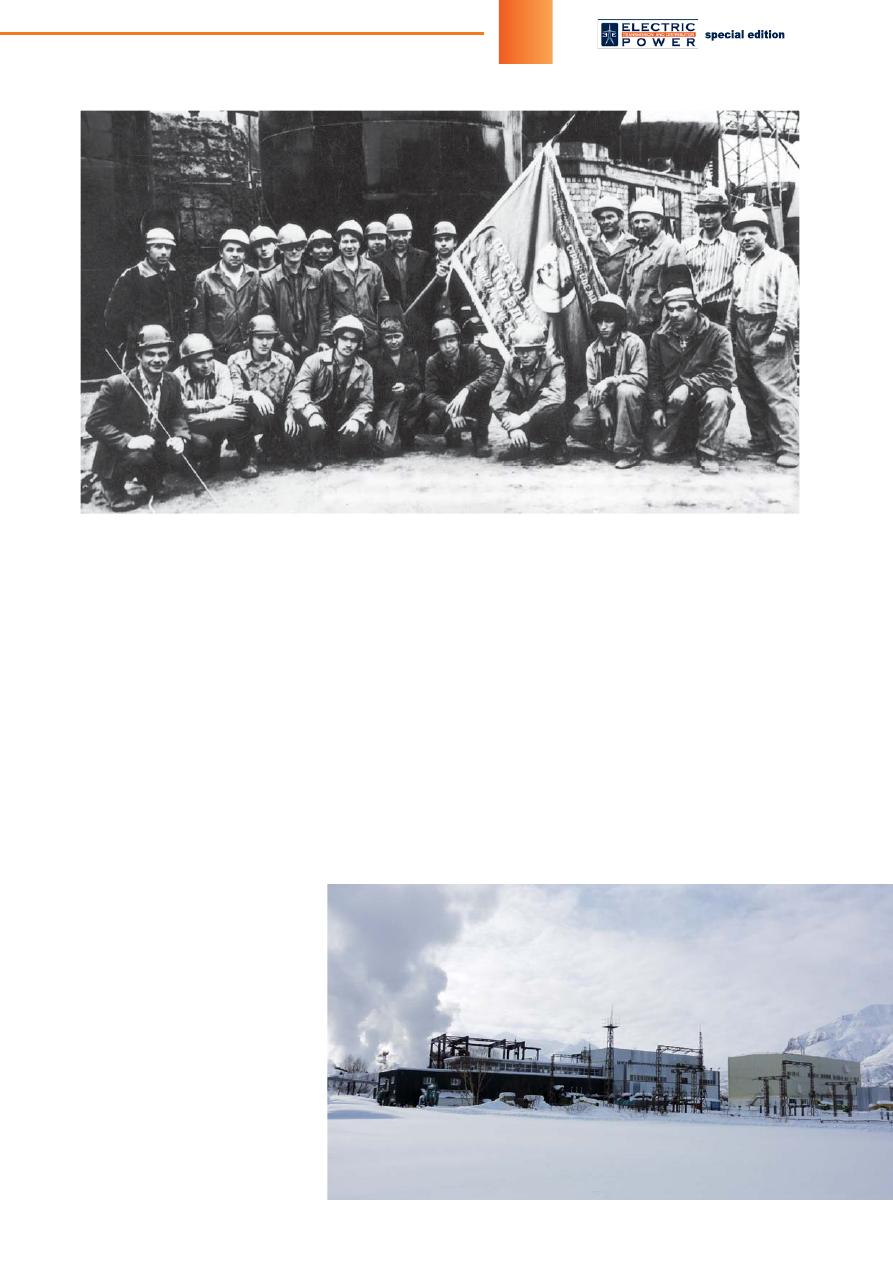
11
Electrical Networks, and further un-
der the supervision of the Admini-
stration the Western, the Central,
the Viluyskie, the Yuzno-Yakutsk
and the Nothern-East electrical
networks turned up to be. In 1964
on the basis of the “AlmazEnergo-
Set” enterprise the Western Elec-
trical Networks were organized.
The Central Electrical Networks,
the Yuuzno-Yakutsk Electrical Net-
works and Energosbyt Yakutsk-
Energo were organized in 1965.
In 1963 under auspices of
the “SakhalinEnergo” regional
electricity board the Sakhalin
island power grid was organized.
In addition, with a new dec-
ade beginning the active work
on heating system introduction
of the Far East cities started. In
Vladivostok the heating enterprise
was put into operation in 1961,
and in 1964 on the “SakhalinEn-
ergo” regional electricity board
order the Khabarovsk heat net-
works were formed. Another im-
portant event took place in 1968:
the Far East Power Grid Interre-
gional Dispatching Of
fi
ce – the
IDO of the East was established.
It consolidated previously isolat-
ed regional power grids under its
authority.
In 1970 the Khabarovsk region
and the Amur River region power
grids were integrated. Due to the
35 kV HVTL with 2 substations
and the HVTL Khabarovsk-
Birobidjan putting into operation
the new regional power grid in
the Jewish Autonomous Territory
was completed. The same year
the Khabarovsk-Raichikhinskaya
SDPP 220 kV HVTL was put
into operation. As a result of that
line construction the Khabarovsk
and the Amur power grids were
integrated. That line brought
a great possibility to provide
Birobidjan, the south of the
Jewish Autonomous Territory,
the Teploozersky cement works
and the Obluchie Region with
electrical power.
Volcano
and Nuclear
Energy
Pauzhetskaya geothermal
power plant (Kamchatka region)
was put into operation as an
experimental one in 1966. At
this moment Pauzhetskaya geo-
thermal power plant is the oldest
geothermal power plant in Russia.
The power plant was constructed
in the south-west of Kamchatka
peninsula in Pauzhetka village.
It uses geothermal steam of
Koshelev and Kambalnov vol-
canos from 10 boreholes.
Pauzhetskaya geothermal power plant in winter
Team – the winner of socialist competition for the 1st electrical power unit
of Yuzhno-Sakhalinskaya CHP-1 putting into operation ahead of schedule. 1975

12
At the beginning of exploitation
station installed capacity was only
5 MW. But, nevertheless, in 1980
its installed capacity increased to
11 MW. Now its installed capa-
city is 12 MW, and as a result the
power plant provides electrical
power to the following settlements:
Ozernowskiy, Pauzhetka, Shum-
niy, Zaporozhie and also to numer-
ous
fi
shing industry factories.
In 1973 Bilibinskaya NPP, the
fi
rst world known transpolar NPP,
was put into operation. Its
fi
rst
reactor block was almost 50 times
heavier than the similar reactor
blocks in the world of that time.
Hydroenergetics
of the Far East
In 1930`s for the
fi
rst time
power engineers turned to hydro
potential power of the rivers of
the Far East. In 1964 construction
of one of the most large-scale
HPP in Russia – Zeyskaya
HPP started. Mentioned HPP
became the
fi
rst power plant with
diagonal hydroturbines. The HPP
construction has been continuing
for almost 21 years. Its capacity
after putting it into operation
(in 1985) was 1330 MW. Today
annual average of electrical power
output is 4910 million kWh. Area
of water reservoir is 2419 square
kilometers.
Power
Engineering
Building in
1980-1990`s
In 1980`s three plants were put
into operation at the same time in
the Far East. Due to the electrical
power heavy de
fi
cit and rough
weather conditions some of them
were erected within the advanced
plan.
Kamchatskaya CHP-2 was
put into operation in 1985. The
CHP is in operation still, and it is
one of the most important plants
for providing Kamchatka penin-
sula with electrical power. At
the moment the CHP generates
410 Gcal/h of heat capacity and
160 MW of electrical capacity.
In 1985 Khabarovskaya CHP-3,
the heaviest CHP of the Khaba-
rovsk region power grid, was
also put into operation. The
fi
rst
elec trical power unit was put into
operation in November, 1985, the
second and the third ones were put
into operation in 1986 and 1987
respectively. At the moment the
CHP capacity continues its increas-
ing: the last and the fourth electrical
power unit was put into operation
in 2006. The plant operating on
burning coal and natural gas rated
heat capacity is 1640 Gcal/h, the
electrical capacity is 720 MW.
One year later, in 1986, Anadyr-
skaya CHP, the biggest CHP in
the Chukotka region, was put into
operation. The construction work
on that plant was called “national
construction”. Anadyrskaya CHP
putting into operation allowed
some boiler rooms closing and the
smog level decreasing. Current
characteristics of the plant are
140 Gcal/h of heat capacity and
56 MW of electrical capacity.
Already in the late 1980’s de-
cline of production in the region
started. After that the crisis in al-
most all industry sectors emerged.
The termination of state investment
support, mass priva
tization and
state market collapse caused the
displacement of the Far East from
the interior markets of Russia. The
Far East power engineering in dust-
ry also could not avoid the down-
fall. During 10 years only 2 power
plants have been constructed in
the region: Verkhne-Mutnovskaya
geothermal power plant (Kamchat-
ka Region) and Noglikskaya SDPP
(Sakhalin Region).
In 1999 in the Russian Fe de ration
a new geothermal power plant –
Verkhne-Mutnovskaya geoPP
was put into operation. It is situated
at the hillside of Mutnovsky volcano
in the south-eastern part of Kam-
chatka peninsula. Total capacity of
the power plant is 12 MW. In 2003
in the same Mutnovsky geother-
mal reservoir the 1st construction
Zeyskaya HPP at night

13
the 4th electrical power units of
the Yuzhno-Sakhalinskaya CHP-1
were put into operation. A bit later
gas infrastructure development of
the plant has been ful
fi
lled.
In 2013 part-time set-up proce-
dure of Ust-Srednekanskaya HPP
took place in the Magadan Region.
Its installed capacity is 570 MW.
However, in 10’s of the new
century the most important event
for the Far East power engineering
industry became the decision of
construction of four priority power
engineering units: CHP in the
city of Sovetskaya Gavan, the
1st construction stage of the Sa -
kha linskaya SDPP-2, the 1st con-
struction stage of the Yakut skaya
SDPP-2 and the 2nd construction
stage of the Blagoveshchenskaya
CHP. Special-purpose budgetary
re sources for its erection of the
amount of more than 50 billion
rubles were given according to
the Russian Federation President
decree dated 2012 about the JSC
“RusHydro” capitalization.
The new units will realize
generating capacity gain, satisfy
increasing demand for heat and
electrical power, replace retired
capacity of the operating CHP
and SDPP and also create the
additional capacity reserve and
increase customers` power supply
reliability.
stage of Mutnovskaya geothermal
power plant was erected. Today the
installed capacity of Mutnovskaya
geothermal power plant is 50 MW.
Those two plants provide up to 30%
of total electrical power consuming
of Kamchatka load cen ter. That al-
lows to decrease suf
fi
ciently the
dependence of the Kamchatka pen-
insula from the ex pensive imported
fuel oil.
In addition, in 1999 in the Sa-
kha lin Region Noglikskaya gas
turbine power plant started ope-
rating. Its electrical capacity is
48 MW now.
Reconstruction
Step by Step
Along the beginning of 2000’s
the Russian Federation entered
a new development stage – the
stage of reconstruction. Slowly but
steadily the Far East power grid
started the process of renovation.
So, in 2003 the largest regional
power plant – Bureyskaya HPP
was put into operation. The plant
construction work started already
in 1976. The basic facilities erec-
tion started in 1984. Till 1988 the
con struction went as planned, how -
ever in 1989 it was almost stopped
due to the budget slash. After
10 years, RAO UES assign to Bu-
rey skaya HPP a status of the ma-
jor object for investments. As a re-
sult solemn ceremony of the HPP
start up took place in July, 2003.
The Russian Fede ration Pre sident
Vladimir Putin pushed the “start”
button within the ceremony as
a symbolic act of HPP connection
to the power grid. In October, 2009
HPP achieved its installed capacity
and since that time started to gene-
rate 7100 million kWh a year.
It is planned that after the startup
of Nizhne-Bureyskaya HPP with
the installed capacity of 320 MW,
both HPP will form Bureyskiy Cas-
cade of power plants.
In 2004 within the realization of
the state program on reconstruction
of power engineering industry and
according to the Russian govern-
ment decree JSC “Rus Hydro” was
founded. It has con tributed signi
fi
-
cantly to the acceleration of the Far
East power engi
neering industry
development.
Large-Scale
Plans of a New
Decade
The Far East power engineering
industry continues its development
in the beginning of a new decade.
In 2012 and 2013 the 5th and
Yakutskaya SDPP-2
Оригинал статьи: Century of the Far East Power Engineering
More than a century has passed since the time when on the Far East territory of Russia the first electrical power plants were put into operation: the cities have lit up with the light of electrical street lamps and the first trams have started to run up and down the streets. For those years everything has happened in the power engineering sphere: shock-work construction, valiant labor, wars, recession and renewal… Today we remember how the history of power engineering from the first lokomobile to the modern HPP has been forming.






